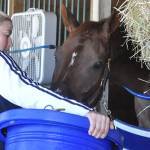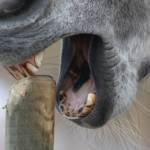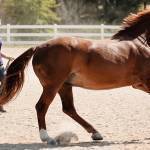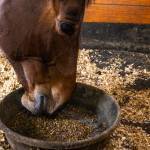Question
I have a 10-year-old Warmblood gelding. I think he’s in perfect weight for his 16.2-hand frame. He is fed 8-10 flakes of timothy hay and ration balancer. He doesn’t work very hard, just some light trail riding and arena work, though his workload will soon increase. He’s had two episodes of gas colic in the last three weeks, which coincides with his move to a new barn and limited turnout. He cribs while being saddled, using his own tongue as a fixture. He tries to do the same thing when longeing sometimes. Under saddle, he bites at his sides and doesn’t want to go forward. I’ve ordered RiteTrac, hoping this might help him.
Answer
RiteTrac is a great product to try with your gelding, as it provides both gastric and hindgut support. Management choices (such as reduced turnout) and diet changes can cause the digestive disorders you have observed. Adding a hindgut buffer like EquiShure, which is an ingredient in RiteTrac, can help stabilize the hindgut and help minimize health problems associated with diet transitions such as changes in hay and concentrates.
Allowing your gelding time to slowly adjust to his new routine and diet is recommended to support mental and physical health. Training schedules for horses at risk of or with a history of gastric ulcers should incorporate rest days to help reduce stress associated with high-intensity exercise. This will help maintain a healthy digestive tract. If there is no access to grazing, then hand-grazing can provide a pleasant break from the stall and the chance to forage.
A ration balancer is a great way to supply essential nutrients in a low calorie and low intake form. Another product that may help during this transition is a joint health product like KER’s EO-3 or Synovate HA.








